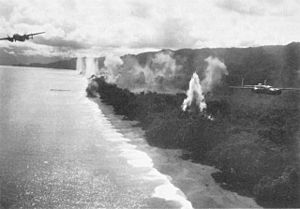Bombing of Wewak facts for kids
Quick facts for kids Bombing of Wewak |
|||||||
|---|---|---|---|---|---|---|---|
| Part of World War II, Pacific War | |||||||
 13 August 1943, a pair of B-25 Mitchells bombs the Wewak area, in the lead-up to the devastating raids of 17 and 18 August. |
|||||||
|
|||||||
| Belligerents | |||||||
| Commanders and leaders | |||||||
| George Kenney | Kumaichi Teramoto | ||||||
| Strength | |||||||
| 47 heavy bombers; 53 medium bombers; 80 fighters |
200 aircraft | ||||||
| Casualties and losses | |||||||
| 10 destroyed | 174 put out of action: 54 shot down 16 blown up 57 badly damaged 47 slightly damaged |
||||||
The Bombing of Wewak was a series of big air attacks during World War II. These attacks happened from August 17 to 21, 1943. The US Army Air Force's Fifth Air Force bombed a major Japanese air base in New Guinea at a place called Wewak.
These four raids, over five days, were a huge win for the Allied forces. The Japanese Fourth Air Army lost about 170 planes. Many were destroyed on the ground or shot down in the air. This left them with only about 30 planes that could still fly. The US Fifth Air Force lost 10 aircraft during these attacks.
Why Wewak Was Attacked
By August 1943, the Japanese Fourth Air Army had 200 planes. But only 130 of them were ready to fly. Many pilots were sick, and they didn't have enough new planes to replace damaged ones. Still, they had some advanced fighter planes. These included the fast Hayabusa ("Oscar") and the powerful Hien ("Tony").
During the fighting around Lae, the Japanese moved many of their planes. They sent them to airfields near Wewak, which was about 400 miles (650 km) west. This was too far for Allied fighter planes to reach from their bases. This meant that large Allied bomber planes would be at risk if they flew to Wewak without fighter escorts.
The Allied air commander, Major General George Kenney, came up with a clever plan. He wanted to launch a big attack on Wewak. First, Allied teams built two fake airfields near Japanese positions. They made lots of dust to make it look like a big construction project. The Japanese fell for the trick and bombed these fake airfields often.
At the same time, the Allies secretly built a real airfield at Tsili Tsili. This was about 50 miles (93 km) away. They moved fighter planes there before the Japanese found out. This new base allowed Allied fighters to fly much further.
Before the main attacks, on August 12, the Japanese Fourth Air Army started bombing Allied air bases. These included places like Mount Hagen and Wau. The Allies also made some small raids on Wewak.
The Air Raids Begin
On August 17, the main attacks began. Forty-seven B-24 Liberator and B-17 Flying Fortress bombers attacked before dawn. They hit the main base at Wewak and other nearby airfields. These included Boram, Dagua, and But.
The Japanese planes were parked very close together on the runways. At Boram, 60 Japanese planes were warming up. Some tried to take off but were destroyed right away. Later that morning, more than 30 B-25 Mitchell bombers arrived. They were protected by over 80 P-38 Lightning fighter planes. These planes flew low and fired their guns at the airfields.
Another attack happened on the morning of August 18. Bombers flew low to shoot and bomb the airfields. The 3rd Attack Group hit Wewak and Boram. The 38th Bomb Group attacked Dagua and But. Each of the 62 bombers carried many small "para-frag" bombs. These bombs were designed to explode above the ground and cause widespread damage.
Later, B-24s from the 90th Bomb Group bombed Wewak from high in the sky. Then, 53 B-25s attacked the airfields again. Only three US planes were lost in these raids. In one of these losses, Major Ralph Cheli was awarded the Medal of Honor for his bravery.
The Japanese were not ready for these attacks. Their airbases in New Guinea did not have good shelters for planes. They also relied on a simple warning system. This system didn't give them enough time to get planes into the air or hide them. These problems, plus poor runways and not enough repair staff, made things worse. During this time, at least half of all Japanese planes lost were destroyed on the ground.
Two more raids took place on August 20 and 21. The Fifth Air Force said they destroyed 20 planes on August 20. On the last day, they claimed 70 planes, with half shot down by P-38 fighters.
What Happened Next
Colonel Kazuo Tanikawa, a Japanese officer, later said that their defenses were not ready. He stated that they lost 100 planes in the first two days. He called it a "decisive Allied victory." He also said that this attack crippled their air power. This meant they couldn't help their ground forces, which was a big reason they lost the war.
The Japanese Fourth Air Army reported that out of 200 planes, 174 were put out of action. This included 54 shot down, 16 blown up, and many others badly or slightly damaged. This left the Fourth Air Army with only about 30 planes that could fly.
This meant that Japanese air operations in New Guinea almost completely stopped. They couldn't do much until new planes arrived. The Allies could now fly their planes without much opposition. They could reach as far as Aitape, which was much further than before.
The Fourth Air Army did recover a bit, but it never got back to its strength from August 1943. The last major air battle between Allied and Japanese planes in New Guinea happened on June 3, 1944. By that time, the Fourth Air Army had almost completely disappeared.
Images for kids


